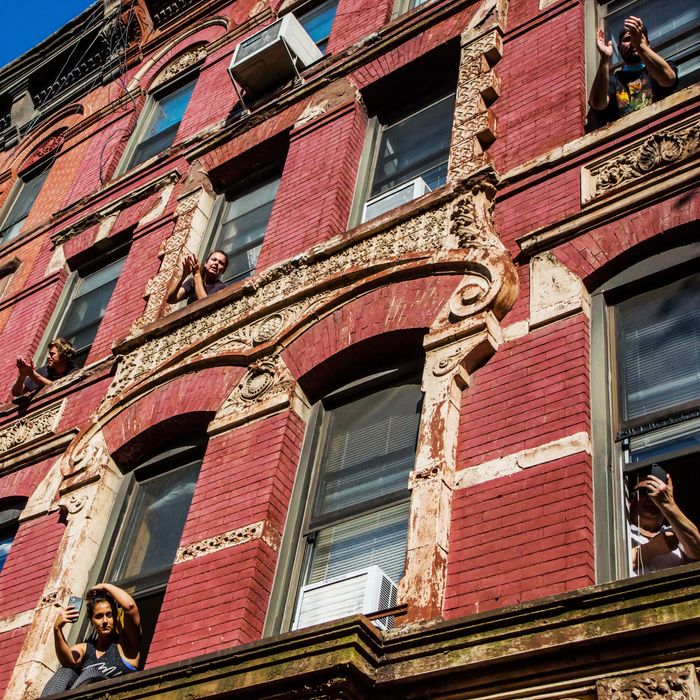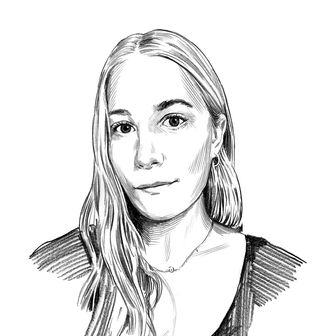
Silence
It started with too much quiet. In New York, in March, it began with a kind of anxious, paranoid hush in places that usually buzzed: On the subway, people stared at those who were already wearing masks, holding the poles with gloved hands. I went to my last dinner out, and the restaurant felt cavernous; I could hear every clink of silverware on the plates. Eventually, finally, we were told to stay home (if we could), and suddenly I heard almost nothing. There was silence where there had once been regular sounds that told me what time of day it was. No friendly robot asked me to “Please stand clear of the closing doors”; there was no morning traffic on Atlantic Avenue, no people leaning on their horns and telling each other what they should do to themselves. No kids got out of school down the street at 3 p.m.
Sirens
Within days, the sirens started. New York was the COVID-19 epicenter of the world, and if you didn’t read that fact somewhere, you heard it every night wailing red into your windows. I listened harder than I ever had. Each time an ambulance went by, questions trailed behind: Was someone already inside? Or were they going to pick someone up? What would happen when they got there? On the news, too, we heard the sirens soundtracking dire reports from the hospitals. Doctors begged publicly for more masks, more gloves. The city was digging mass graves; the city was bringing a ship into the harbor with hundreds of beds. For all the cacophony, the governor’s press conferences were disconcertingly monotonous, delivered in power points in primary colors, as if they were taking place somewhere else. After, the sirens started up again, pealing. There were more at night, it seemed.
Clapping
Around April, we started to hear clapping every evening at 7 p.m. for the people who went to work each day, who weren’t able to shelter in place or stay at home: doctors and nurses, delivery drivers, postal workers, grocery-store employees. From their windows and their stoops, hundreds of New Yorkers banged pots and pans. They played disco. They flew banners that said, “THANK YOU.” They sang opera and played string instruments. The sirens still whined, but the new ritual was something to break them up, something to look forward to. It became a place to gather when we couldn’t actually go anywhere. I live next to a gas station instead of another apartment building, so I took walks to hear it and to see my neighbors, all of them doing the same thing at the same time for a few minutes.
Protest
On May 31, New York exploded in noise. We had watched George Floyd die on camera under Derek Chauvin’s knee, and then we watched people in Minneapolis burn down a police precinct. I went out every night for a week, and I knew where to go from the waves of sound: protesters chanting names, stomping that made the street bounce. It was joyful even when it was despairing — rage lighting people up. Protesters sang even when they were trapped for hours on the Brooklyn Bridge one night, kettled in on either side by the NYPD. Marching was almost as good as touching each other again.
In between the sounds of protests, fireworks popped. The whole city was on edge, but it also felt open, overflowing. Other times, I heard the sounds of it being closed off, noises that told me when to run. Helicopters circled overhead to watch where demonstrators were gathering. Cops spoke into bullhorns, told people to get back, keep moving, get on the sidewalk, get off the sidewalk. One night after curfew, I heard people screaming and running in a stampede after they were chased down my block. When the coast was clear, they gathered again, crying through milk they poured into their stinging eyes and down their faces.
Quiet
By the end of the summer it was starting to feel like the city was holding its breath. A cold snap came, emptying the parks and the pools that had finally opened. It was a glimpse of the winter that was coming. There was a lot of waiting going on in lines for tests as the infection rates crept up, as we all started hearing that the second wave was beginning. Then, we waited in long lines to vote, on damp, rainy days that seemed to indicate a bigger gloom than just the weather. We were waiting to see who was in charge, but also waiting to know how much it would really matter, and would it matter soon enough.
Music
I learned that Donald Trump had lost the presidential election from the cheers. It was around noon on Saturday, an unseasonably bright and warm November day, and a woman on the street suddenly started clapping and jumping and talking to some people who had come out onto their fire escape, who were jumping too. Another woman burst out of an upstairs window, the whole top half of her body hanging out, to shout about CNN; the cars coming down the street were honking. All day it was like that, where one person would make noise, and it seemed like the world followed.
Because people couldn’t mark the occasion inside — with friends or family, in restaurants and bars — everybody was forced out into the sunshine, and huge, public celebrations seemed to sprout up everywhere. More than anything else, I heard music — from big sound systems and handheld speakers, from passing bikes with stereos. Bus drivers danced; children danced; old people danced. I don’t know if, had we not been kept apart for eight months, people would have run outside first, to be with strangers before turning on their TVs.
After days of total uncertainty, the spontaneity was reassuring. The spasm of joy and relief was something real, even if it was brief. It was one more weekend outside. A guy who danced near me on the street was muttering to himself, “Just a day, just a day, just a day, just a day.”


